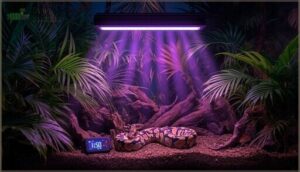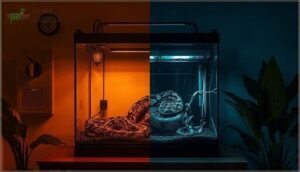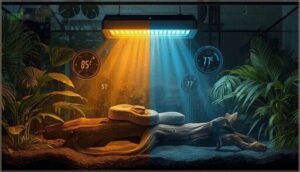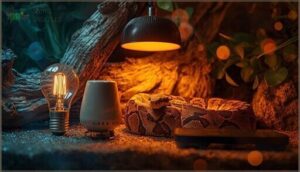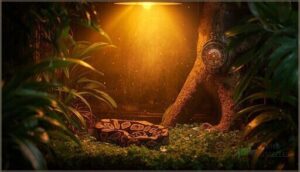This site is supported by our readers. We may earn a commission, at no cost to you, if you purchase through links.

Ceramic heat emitters deliver consistent thermal output without light emissions, making them perfect for nighttime heating. Halogen bulbs provide energy-efficient daytime heating with natural light patterns. Overhead heating creates more natural thermal distribution than undertank heaters, warming the entire air column effectively.
You’ll also need reliable temperature monitoring tools and timers for consistent photoperiod control. The right setup transforms your enclosure into a perfectly controlled environment where your ball python can thrive year-round.
Table Of Contents
- Key Takeaways
- Top 6 Best Heat Lamps for Ball Pythons
- Do Ball Pythons Need a Heat Lamp?
- Proper Lighting and Temperature Setup for Ball Pythons
- Heating Methods for Ball Python Enclosures
- Maintaining Ideal Humidity Levels for Ball Pythons
- Frequently Asked Questions (FAQs)
- What heat lamp is best for ball python?
- What is the best heating element for a ball python?
- Can you leave a heat lamp on 24 7 for ball python?
- How many watts for ball python heat lamp?
- Do ball pythons need a light bulb?
- Can a ball python be heated?
- What do I need for a ball python heating setup?
- What is your favorite heating amenity for a ball python?
- Which light source is best for a ball python?
- Do ball pythons need UVB light?
- Conclusion
Key Takeaways
- You’ll need ceramic heat emitters for 24/7 heating – they provide consistent warmth without light disruption, maintaining proper nighttime temperatures while your snake sleeps.
- Create precise temperature gradients with 90-95°F basking spots – overhead heating works better than under-tank heaters for natural thermal distribution throughout your enclosure.
- Use reliable monitoring equipment like infrared thermometers – accurate temperature tracking prevents dangerous fluctuations that can stress your ball python or cause health issues.
- Combine heating with proper humidity control at 50-60% – heat lamps can reduce moisture levels, so you’ll need humid hides and strategic substrate choices to maintain ideal conditions.
Top 6 Best Heat Lamps for Ball Pythons
Choosing the right heat lamp for your ball python isn’t just about warmth—it’s about creating a proper thermal gradient that keeps your snake healthy and active.
You’ll need to take into account factors like bulb type, wattage, safety features, and how well each option maintains the critical 90-95°F basking temperature your ball python requires.
1. Zoo Med ReptiSun T5 HO UVB Lamp
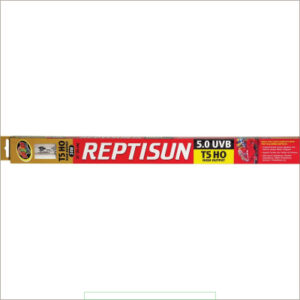
You’ll consistently find the Zoo Med ReptiSun T5 HO UVB Lamp delivering outstanding UVB Lighting for your ball python’s enclosure. This Reptile Heat Lamp stands out with its proven ReptiSun Features and remarkable T5 Benefits.
Professional-grade UVB performance that reptile experts trust for consistent thermal results
Here’s what makes this UVB powerhouse shine:
- Double strength output compared to standard ReptiSun 5.0 lamps
- Professional-grade reliability trusted by reptile experts worldwide
- Excellent Heat Distribution that covers enclosures of all sizes
- Strong metabolic support preventing bone disease in reptiles
While Lamp Durability usually surpasses expectations, monitor for occasional early burnout. The unit’s length might challenge smaller setups, but its UVB Lights performance makes it worthwhile for serious Ball Python Care. This Reptile Lighting solution delivers consistent results when proper UVB exposure matters most.
Best For: Ball python habitats requiring reliable, professional-grade UVB Lighting.
2. Solarmeter Reptile UV Index Meter
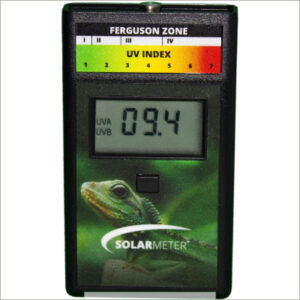
You’ll want precise UV measurement for your ball python setup, and the Solarmeter Reptile UV Index Meter delivers exactly that. This compact device measures UV from 280-400 nanometers with outstanding Meter Accuracy, perfect for Index Measurement during routine maintenance. The single button operation makes UV Meter Calibration simple. At 4 ounces and 4.2 x 2.4 x 0.9 inches, it’s portable yet durable for long-term use.
While ball pythons don’t require UVB Lights, this meter provides confidence if you’re experimenting with UVA UVB supplementation. It helps verify your Reptile Lighting isn’t creating harmful exposure levels that could disrupt your snake’s natural behavior patterns.
Best For: Snake keepers monitoring Solar Simulation in terrariums with mixed Reptile Heat Lamp and lighting systems.
3. Flukers Heavy Duty Clamp Light
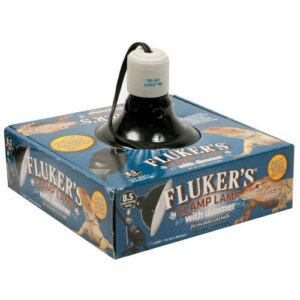
When choosing reliable heating equipment, you’ll find the Flukers Heavy Duty Clamp Light stands out as a top performer for ball python enclosures. This UL/CUL approved fixture accommodates up to 150-watt bulbs with its durable ceramic socket, preventing the melting issues you’d face with cheaper plastic alternatives.
The integrated dimmer switch gives you precise temperature control—no more guessing games with your snake’s comfort. Its heavy-gauge aluminum construction means this lamp won’t quit on you after a few months like flimsy competitors.
The 8.5-inch clamp design secures firmly to tank edges up to 1 inch thick, while the swivel head lets you target the perfect basking spot. Whether you’re using ceramic heat emitters, halogen bulbs, or standard incandescent lights, this flexible fixture adjusts to your setup needs without breaking your budget. Understanding the proper heat levels is essential for maintaining a healthy environment for your ball python.
Best For: Ball python owners and reptile keepers who need a reliable, adjustable heating solution with professional-grade safety features and precise temperature control.
- Integrated dimmer switch provides precise temperature control with ceramic socket rated for 150W bulbs, preventing overheating risks common in plastic alternatives
- Heavy-gauge aluminum construction and UL/CUL approval ensure long-term durability and safety compliance for continuous reptile habitat use
- Versatile 8.5-inch clamp design with swivel head allows secure attachment to various enclosure types while accommodating multiple bulb types including ceramic heat emitters
- Higher wattage bulbs (75W) may generate excessive heat in smaller dome configurations, requiring careful wattage monitoring or deeper fixtures
- Some quality control issues reported with occasional defects or premature bulb failures affecting product reliability
- Smaller dome size may not accommodate larger specialty UVB bulbs without additional suspension hardware
4. GE 24 Hour Mechanical Timer
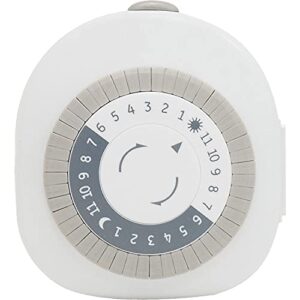
Between setup and operation, the GE 24 Hour Mechanical Timer transforms your ball python’s habitat management. You’ll program up to 48 daily on/off cycles using simple push-pins, creating consistent day-night temperature patterns your snake needs. The mechanical dial operates at 30-minute intervals, supporting precise basking schedules without digital complexity.
This timer accommodates 1250W loads safely, making it perfect for ceramic heat emitters and halogen bulbs. The override switch lets you bypass programming when needed. While the mechanical clicking might sound like a pocket watch, it’s reliable and retains settings during power outages. Just remember—it’s indoor-use only and won’t control heating appliances with elements.
Best For: Ball python owners who want reliable, automated heating and lighting schedules without the complexity of digital timers.
- Simple mechanical operation with 48 daily on/off cycles at 30-minute intervals for precise temperature control
- Handles 1250W loads safely, perfect for ceramic heat emitters and halogen bulbs used in reptile habitats
- Retains programming during power outages and includes override switch for manual control when needed
- Indoor-use only limitation restricts placement options for some terrarium setups
- Cannot control heating appliances with elements, limiting compatibility with certain reptile heating devices
- Bulky design may block adjacent outlets and setup instructions can be unclear requiring trial-and-error
5. Infrared Thermometer Temperature Gun
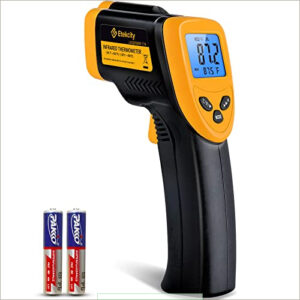
Accurate temperature monitoring is essential for your ball python’s health, and an infrared thermometer delivers precise surface readings without disturbing your snake. This device features a 12:1 distance-to-spot ratio, letting you measure temperatures from 14 inches away with ±2°F accuracy.
The adjustable emissivity settings work perfectly on glass, plastic, and substrate surfaces common in reptile enclosures.
With its backlit LCD display and 0.5-second response time, you’ll get instant readings even in low-light conditions. The wide temperature range covers all heating elements, while the auto-off function preserves battery life during regular habitat checks.
Best For: Ball python keepers who need accurate, non-contact temperature monitoring to maintain proper thermal gradients in reptile enclosures without disturbing their snake.
- Fast 0.5-second readings with ±2°F accuracy and adjustable emissivity for different enclosure materials
- 12:1 distance-to-spot ratio allows safe measurement from 14 inches away without stressing your snake
- Backlit LCD display works well in low-light conditions typical of reptile room monitoring
- Not suitable for measuring body temperature directly on your ball python
- Requires regular calibration every 3-6 months to maintain optimal accuracy
- May give inaccurate readings on highly reflective surfaces like glass without proper angle adjustment
6. Inkbird Temperature and Humidity Monitor
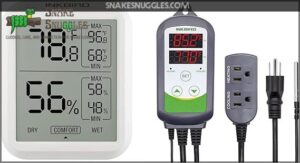
Most reptile keepers swear by the Inkbird Temperature and Humidity Monitor for maintaining perfect ball python conditions. This reliable device displays both °C and °F readings with dual relay capability that automatically controls your heating equipment. The comfort indicator shows humidity levels instantly through easy-to-read icons.
You’ll appreciate its accuracy within ±0.5°C and ±3% humidity, plus the 10-second sampling updates that keep you informed. The digital LCD screen provides clear visibility during nighttime checks, while the plug-and-play setup requires zero technical skills.
Whether wall-mounted or tabletop, this monitor helps prevent dangerous temperature swings that stress your snake.
Best For: Ball python owners and reptile keepers who need precise environmental monitoring with automated heating control to maintain optimal terrarium conditions.
- High accuracy with ±0.5°C temperature and ±3% humidity readings, plus dual relay system for automatic equipment control
- Real-time monitoring with 10-second updates and clear digital display for immediate feedback on enclosure conditions
- Plug-and-play installation with flexible mounting options and proven 98% reliability over two-year warranty periods
- Limited temperature range (-10℃ to 50℃) may not suit extreme climate applications or specialized reptile species requirements
- Requires constant power supply with no battery backup option, making it vulnerable during power outages
- May need additional equipment purchases like heaters or humidifiers to fully utilize the automated control features
Do Ball Pythons Need a Heat Lamp?
Ball pythons absolutely need a reliable heat source to regulate their body temperature and maintain proper metabolism. You’ll want to create a temperature gradient with a warm basking spot of 90-95°F and cooler areas around 78-80°F for ideal health.
Overhead Heating Vs. Under Tank Heating
When considering heat source comparison for your ball python, overhead heating creates a more natural thermal distribution than undertank heaters. Heat lamps provide exceptional heating efficiency by warming ambient air, while heat mats only heat surfaces. This reptile heating method produces better temperature gradients throughout the enclosure.
Consider these key differences:
- Heat source placement – Overhead mimics natural sunlight patterns
- Thermal distribution – Lamps warm entire air column effectively
- Tank insulation – Heat rises naturally from overhead sources
- Energy efficiency – Ceramic emitters run continuously without cycling
- Safety factors – Reduced burn risk compared to direct surface contact
To achieve ideal ball python care, understanding temperature gradient requirements is essential for creating a healthy environment.
Basking Spot Temperature Requirements
Your ball python’s basking spot needs precise warmth levels between 95-104°F for proper thermoregulation. This basking surface temperature creates the ideal temperature range your snake requires for digestion and metabolic functions.
Temperature gradients allow your python to self-regulate by moving between heat sources. Use thermal monitoring equipment like digital thermometers to track basking temperatures accurately.
Proper ball python care depends on maintaining these consistent warmth levels in the basking spot.
Nighttime Temperature Drop
Since temperature regulation mimics natural habitat conditions, your ball python requires nighttime cooling from 95-104°F daytime temperatures down to 70-78°F. This thermal cycling aids proper metabolism and prevents temperature fluctuation stress.
Here’s your temperature control setup:
- Install a ceramic heat emitter with thermostat for gentle nighttime warmth without light disruption
- Position heat lamp timers to create natural temperature gradient shifts at dusk
- Monitor drop prevention systems to avoid dangerous temperature crashes below 70°F
Proper Lighting and Temperature Setup for Ball Pythons
Setting up proper lighting and temperature for your ball python requires careful attention to both heat and light cycles. You’ll need to create a temperature gradient with a warm basking area of 90-95°F and cooler zones around 78-80°F, while maintaining a consistent 12-hour day-night lighting schedule.
UVB Lighting Considerations
While UVB lighting isn’t required for ball python survival, it can boost your snake’s overall health. UVB helps with vitamin D3 synthesis, supporting metabolism and bone strength. Studies show UVB exposure increases vitamin D levels tenfold compared to no exposure.
The UVB light spectrum between 290-320 nanometers works best for reptile health. You’ll want a T5 HO fluorescent tube placed 9-15 inches overhead. This setup allows your snake to self-regulate UVB intensity through cryptic basking behavior.
Photoperiod control matters too. Lighting cycles that mimic natural patterns support thermoregulation and reduce stress. Both UVA UVB and visible light contribute to environmental awareness, though your python can thrive without them.
Replace UVB bulbs every 12 months to maintain effectiveness. While not essential, proper UVB provision can improve immune function and reproductive success in captive ball pythons. For superior results, understanding UVB lighting is vital for ball python owners.
Day-Night Lighting Cycle
Proper photoperiod control mimics your snake’s natural circadian rhythm. Your ball python’s thermoregulation depends on consistent light cycles that signal day and night periods.
Here’s how to establish effective diel lighting:
- 12-hour photoperiod – Run heat lamps and UVA UVB lights for exactly 12 hours daily
- Timer automation – Use digital timers to maintain consistent lighting setup without manual switching
- Gradual shifts – Install dimmer switches for smooth dawn-dusk changes that reduce stress
- Complete darkness – Make certain total light elimination during night hours for proper hormone regulation
Temperature control works hand-in-hand with your lighting schedule. Thermal gradients remain active even when primary heat lamps cycle off, maintaining basking zones through ceramic heat emitters or panels.
Ambient Air Temperature Range
Maintaining proper ambient tank temperature creates the foundation for your ball python’s health. You’ll need heat gradients with warm sides reaching 80-85°F and cool zones staying 75-80°F. This thermal balance mimics natural environments perfectly.
Use temperature monitoring tools and make certain adequate air circulation throughout the enclosure. Climate control systems help maintain consistent temperature regulation.
Your basking surface temperature should peak at 88-92°F, while nighttime drops support natural rhythms. Proper temperature control prevents stress and promotes healthy digestion in your snake.
Heating Methods for Ball Python Enclosures
You’ll need to choose the right heating method based on your enclosure type and setup preferences. Each option offers different benefits, from halogen bulbs that provide both heat and light to ceramic emitters that deliver steady warmth without disrupting sleep cycles.
Halogen Flood Bulbs
Halogen flood bulbs deliver Energy Efficiency and exceptional Heat Output for your ball python’s basking spot. These reptile heat lamps reach ideal temperatures within minutes while consuming 20-30% less electricity than standard incandescent options.
Halogen Benefits include broad-spectrum infrared heat mimicking natural sunlight. Always prioritize Flood Bulb Safety by using ceramic fixtures and protective cages.
With proper installation, expect impressive Bulb Longevity exceeding 2,000 operational hours. The selection of flood bulb types is vital for maintaining the right temperature in ball python enclosures.
Ceramic Heat Emitters
With ceramic heat emitters, you’ll get consistent thermal output without disruptive light emissions. These durable ceramic heat lamps excel at heat distribution while maintaining emitter safety through proper ceramic socket installation.
Key ceramic emitter benefits:
- 24/7 Operation – Maintains steady temperatures without affecting sleep cycles
- Enhanced Durability – Ceramic construction withstands constant heating cycles
- Safe Design – No light emission prevents behavioral disruption
- Efficient Heat Distribution – Broad thermal coverage across basking areas
Your reptile heat lamp setup becomes more reliable with ceramic emitters’ consistent performance. Proper temperature control systems are essential for creating a suitable environment for ball pythons.
Radiant Heat Panels
Radiant heat panels transform your ball python’s terrarium into a perfectly controlled environment. Panel installation on the ceiling delivers consistent heat distribution without hot spots that stress your snake. Their thermal efficiency surpasses traditional heat lamps, while safety features prevent burns.
These sleek panel materials provide gentle infrared heat that penetrates surfaces naturally, creating ideal basking zones your python will love. Using reptile heat panels can substantially enhance the overall comfort and well-being of your ball python.
Avoiding Heat Rocks
Heat rocks pose serious Heat Rock Dangers to your Ball Python. These devices create hotspots that can burn your snake’s delicate belly scales. Unlike proper Heat Source Alternatives, heat rocks don’t establish a healthy Thermal Gradient throughout your Safe Enclosure.
Consider these safer options for Temperature Control:
- Heat Lamp systems provide overhead warmth
- Ceramic heat emitters offer consistent heat without light
- Under-tank heaters create belly heat safely
- Reptile Heat Lamp setups allow proper Thermoregulation
Always prioritize Heat Lamp Safety over convenience. Proper Ball Python Heat management is vital for the well-being of your pet, and understanding the best Ball Python Heat solutions can help you create a safe environment.
Maintaining Ideal Humidity Levels for Ball Pythons
While heat lamps create warmth, they can reduce humidity levels in your ball python’s enclosure. You’ll need to balance proper heating with maintaining 50-60% humidity through strategic substrate choices, controlled misting, and dedicated humid hides.
Substrate Selection
Your ball python’s substrate materials work like a foundation for proper moisture control in the enclosure. Choose bedding options that complement your reptile heat lamp setup while maintaining ideal humidity levels.
Top substrate materials for your snake enclosure:
- Coconut husk: Retains moisture naturally without getting soggy
- Cypress mulch: Balances humidity while preventing mold growth
- Paper towels: Budget-friendly option for easy temperature regulation monitoring
- Aspen bedding: Excellent for dry setups but avoid in high-humidity environments
- Bioactive substrate mix: Creates natural ecosystem with beneficial microorganisms
Tank liners offer convenience but limit humidity control compared to natural substrates that support your ball python’s health. Understanding ball python substrate options is vital for creating an ideal environment.
Misting Techniques
Proper misting schedules maintain ideal humidity levels for your Ball Python’s comfort. Use a pressure sprayer with dechlorinated water for even distribution across substrate surfaces. Mist daily, particularly evenings, to replicate natural patterns. Fogging systems aren’t recommended as they oversaturate enclosures.
Monitor with hygrometers and adjust misting schedules based on shedding cycles. Target 50-60% humidity normally, increasing to 70-75% during sheds. Avoid pooling water which causes scale rot and bacterial growth.
Humid Hide Enclosure
Within your terrarium, a humid hide acts as essential moisture management for your ball python. Create this hide box using a plastic container with dampened sphagnum moss inside. Position it strategically to work alongside your ceramic heat emitter and heat lamp system.
This enclosure design creates vital temperature gradients while providing targeted humidity control. Your snake can self-regulate moisture needs by moving between different zones in the habitat.
Frequently Asked Questions (FAQs)
What heat lamp is best for ball python?
Ceramic heat emitters and deep heat projectors work best. They provide consistent warmth without disrupting sleep cycles, while halogen bulbs offer natural-spectrum heating during daytime hours.
What is the best heating element for a ball python?
You’ll want a ceramic heat emitter or deep heat projector as your primary heating element. These provide consistent warmth without light, letting your snake maintain natural day-night cycles while staying properly heated.
Can you leave a heat lamp on 24 7 for ball python?
Ball pythons need day-night cycles, so don’t leave heat lamps on continuously. You’ll disrupt their natural rhythm and stress your snake. Instead, use ceramic heat emitters for nighttime warmth.
How many watts for ball python heat lamp?
You’ll need a 50-75 watt bulb for most ball python setups. Larger enclosures might require 100 watts, while smaller tanks work fine with lower wattage options.
Do ball pythons need a light bulb?
You don’t need a traditional light bulb for ball pythons since they’re nocturnal. However, you’ll want heat sources like ceramic heat emitters or infrared bulbs that provide warmth without disrupting their natural day-night cycle.
Can a ball python be heated?
Studies show 95% of ball python health issues stem from inadequate heating.
Yes, you can definitely heat your ball python using ceramic heat emitters, under-tank heaters, or infrared bulbs with thermostats for safety.
What do I need for a ball python heating setup?
You’ll need a heat source like a ceramic heat emitter or heat lamp, digital thermometer, thermostat controller, and proper fixture. This setup creates essential temperature gradients for your python’s health.
What is your favorite heating amenity for a ball python?
Ceramic heat emitters top my list because they deliver consistent warmth without light disruption, letting your snake maintain natural day-night cycles while staying perfectly cozy.
Which light source is best for a ball python?
Contrary to popular belief, you don’t need expensive full-spectrum lighting. Ceramic heat emitters work best—they provide consistent warmth without disrupting sleep cycles, unlike bright bulbs that stress your snake.
Do ball pythons need UVB light?
Ball pythons don’t require UVB light, but it can benefit their overall health and natural behaviors.
You’ll find most keepers skip UVB since these nocturnal snakes thrive with proper heat sources alone.
Conclusion
Establishing precise thermal gradients proves essential for ball python health and natural behavior patterns. The best heat lamps for ball pythons create proper temperature zones that support digestion, immune function, and overall well-being.
Ceramic heat emitters provide reliable nighttime heating without disturbing sleep cycles, while halogen bulbs deliver energy-efficient daytime warmth. Overhead heating systems outperform undertank alternatives by warming the entire air column.
With proper temperature monitoring and consistent photoperiods, you’ll create an ideal environment where your ball python thrives year-round.
- https://www.ncbi.nlm.nih.gov/pmc/articles/PMC8158952/
- https://www.target.com/p/ge-indoor-mechanical-timer-24hr-2-polarized-outlet-big-button-white/-/A-90915176
- https://byjasco.com/products/ge-indoor-plug-in-24-hour-mechanical-timer-white
- https://www.youtube.com/watch?v=iHkhqkeJ0OI
- https://www.reddit.com/r/SavageGarden/comments/10erm5d/mechanical_timer_for_lights_is_making_a_slight/

